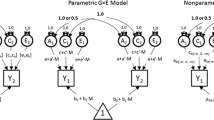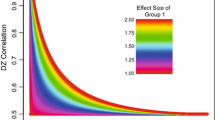Abstract
Purcell (Twin Res 5:554–571, 2002) proposed a bivariate biometric model for testing and quantifying the interaction between latent genetic influences and measured environments in the presence of gene–environment correlation. Purcell’s model extends the Cholesky model to include gene–environment interaction. We examine a number of closely related alternative models that do not involve gene–environment interaction but which may fit the data as well as Purcell’s model. Because failure to consider these alternatives could lead to spurious detection of gene–environment interaction, we propose alternative models for testing gene–environment interaction in the presence of gene–environment correlation, including one based on the correlated factors model. In addition, we note mathematical errors in the calculation of effect size via variance components in Purcell’s model. We propose a statistical method for deriving and interpreting variance decompositions that are true to the fitted model.



Similar content being viewed by others
Notes
The candidate moderator need not be an “environmental” variable in the narrow sense of the word. It could represent an environmental variable such as parenting practices or neighborhood crime, or it could also represent another phenotype being modeled as a precursor to the phenotype of interest.
Models for the simulated examples were fitted and tested in Mplus v.4.21 (Muthén and Muthén 2006). Scripts and output files are available for download from the first author’s web site at http://www.health.bsd.uchicago.edu/rathouz/GxM.
Currently available structural equations modeling software such as Mplus (Muthén and Muthén 2006) or Mx (Neale et al. 2003) does not permit estimation of models (6) or (9) owing to nonlinearity of the A and E terms and difficulties of high-dimensional numerical integration. Development of specialized software to fit these models is an area for future development.
This formula is not explicitly stated but is unambiguously implied by Purcell’s formula for rGE given below in (13).
Recall that we omit shared environmental effects C only for simplicity of exposition; these models can be expanded to include C.
R (R Development Core Team 2005) scripts and output files for obtaining the results in this section are available for download from the first author’s web site at http://www.health.bsd.uchicago.edu/rathouz/GxM/.
References
Burt SA, Mcgue M, DeMarte JA, Krueger RF, Iacono WG (2006) Timing of menarche and the origins of conduct disorder. Arch Gen Psychiatry 63:890–896
Eaves LJ, Last K, Martin NH, Jinks JL (1977) A progressive approach to non-additivity and genotype-environmental covariance in the analysis of human differences. Br J Math Statist Psychol 30:1–42
Eaves L, Silberg J, Erkanli A (2003) Resolving multiple epigenetic pathways to adolescent depression. J Child Psychol Psychiatry 44:1006–1014
Jang K, Dick D, Wolf H, Livesley W, Paris J (2005) Psychosocial adversity and emotional instability: an application of gene-environment interaction models. Eur J Personality 19:259–272
Jinks JL, Fulker DW (1970) Comparison of the biometrical genetical, mava, and classical approaches to the analysis of human behavior. Psychol Bull 73:311–349
Johnson W (2007) Genetic and environmental influences on behavior: capturing all the interplay. Psychol Rev 114:423–440
Johnson W, Krueger RF (2005a) Genetic effects on physical health: lower at higher income levels. Beh Genet 35:579–590
Johnson W, Krueger RF (2005b) Higher perceived life control decreases genetic variance in physical health: evidence from a national twin study. J Personal Soc Psychol 88:165–173
Johnson W, Krueger R (2005c) Predictors of physical health: toward an integrated model of genetic and environmental antecedents. J Gerontol Ser B 60:42–52
Johnson W, Krueger R (2006) How money buys happiness: genetic and environmental processes linking finances and life satisfaction. J Personal Soc Psychol 90:680–691
Kendler K, Aggen S, Prescott C, Jacobson K, Neale M (2004) Level of family dysfunction and genetic influences on smoking in women. Psychol Med 34:1263–1269
Kremen W, Jacobson K, Xian H, Eisen S, Waterman B, Toomey R, Neale M, Tsuang M, Lyons M (2005) Heritability of word recognition in middle-aged men varies as a function of parental education. Beh Genet 4:417–433
Lahey BB, Waldman ID (2003) A developmental propensity model of the origins of conduct problems during childhood and adolescence. In: Lahey BB, Moffitt TE, Caspi A (eds) Causes of conduct disorder and juvenile delinquency. Guilford Press, New York, pp 76–117
Loehlin JC (1996) The Cholesky approach: a cautionary note. Beh Genet 26:65–69
Lubinski D, Humphreys LG (1990) Assessing spurious “moderator effects”: illustrated substantively with the hypothesized (“synergistic”) relation between spatial and mathematical ability. Psychol Bull 107:385–393
MacCallum RC, Mar CM (1995) Distinguishing between moderator and quadratic effects in multiple regression. Psychol Bull 118:405–421
MacCallum RC, Wegener DT, Uchino BN, Fabrigar LR (1993) The problem of equivalent models in applications of covariance structure analysis. Psychol Bull 114:185–199
Moffitt TE (2005) The new look of behavioral genetics in developmental psychopathology: gene–environment interplay in antisocial behaviors. Psychol Bull 131:533–554
Muthén LK, Muthén BO (2006) Mplus user’s guide, 4th edn. Muthén & Muthén, Los Angeles, CA
Neale MC, Boker SM, Xie G, Maes HH (2003) Mx: Statistical modeling, 6th edn. Department of Psychiatry, VCU Box 900126, Richmond, VA 23298
Plomin R, DeFries JC, Loehlin JC (1977) Genotype–environment interaction and correlation in the analysis of human behavior. Psychol Bull 84:309–322
Purcell S (2002) Variance component models for gene-environment interaction in twin analysis. Twin Res 5:554–571
Rice F, Gordon H, Shelton K, Thapar A (2006) Family conflict interacts with genetic liability in predicting childhood and adolescent depression. J Am Acad Child Adolesc Psychiat 45:841–848
R Development Core Team (2005) R: A language and environment for statistical computing. R Foundation for Statistical Computing, Vienna, Austria. ISBN 3-900051-07-0, website: http://www.R-project.org
Rutter M (2006) Genes and behavior: nature–nurture interplay explained. Blackwell, Malden MA
Timberlake D, Rhee S, Haberstick B, Hopfer C, Ehringer M, Lessem M, Smolen A, Hewitt J (2006) The moderating effects of religiosity on the genetic and environmental determinants of smoking initiations. Nicotine Tobacco Res 8:123–133
Acknowledgments
The authors thank Wendy Johnson and Robert F. Krueger for insightful comments on the first draft of this article, which dramatically improved subsequent drafts.
Author information
Authors and Affiliations
Corresponding author
Additional information
Edited by Stacey Cherny.
Rights and permissions
About this article
Cite this article
Rathouz, P.J., Van Hulle, C.A., Rodgers, J.L. et al. Specification, Testing, and Interpretation of Gene-by-Measured-Environment Interaction Models in the Presence of Gene–Environment Correlation. Behav Genet 38, 301–315 (2008). https://doi.org/10.1007/s10519-008-9193-4
Received:
Accepted:
Published:
Issue Date:
DOI: https://doi.org/10.1007/s10519-008-9193-4




